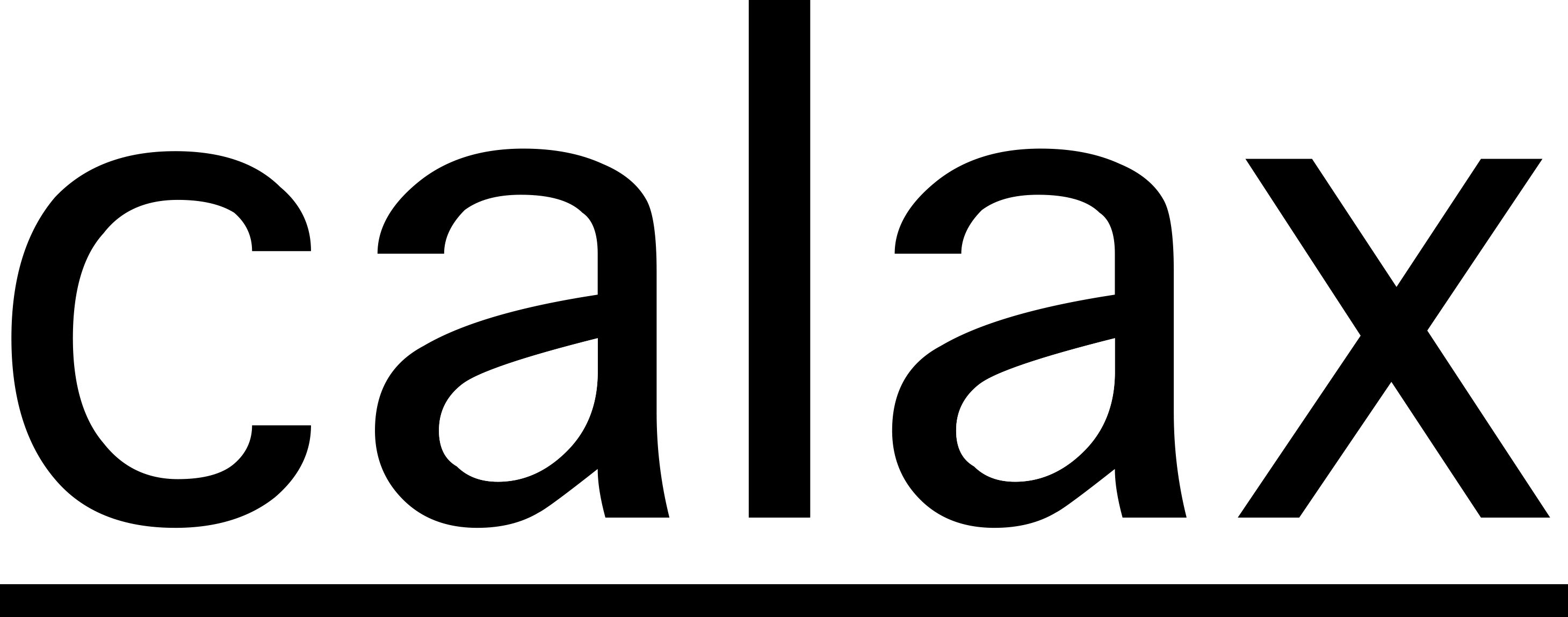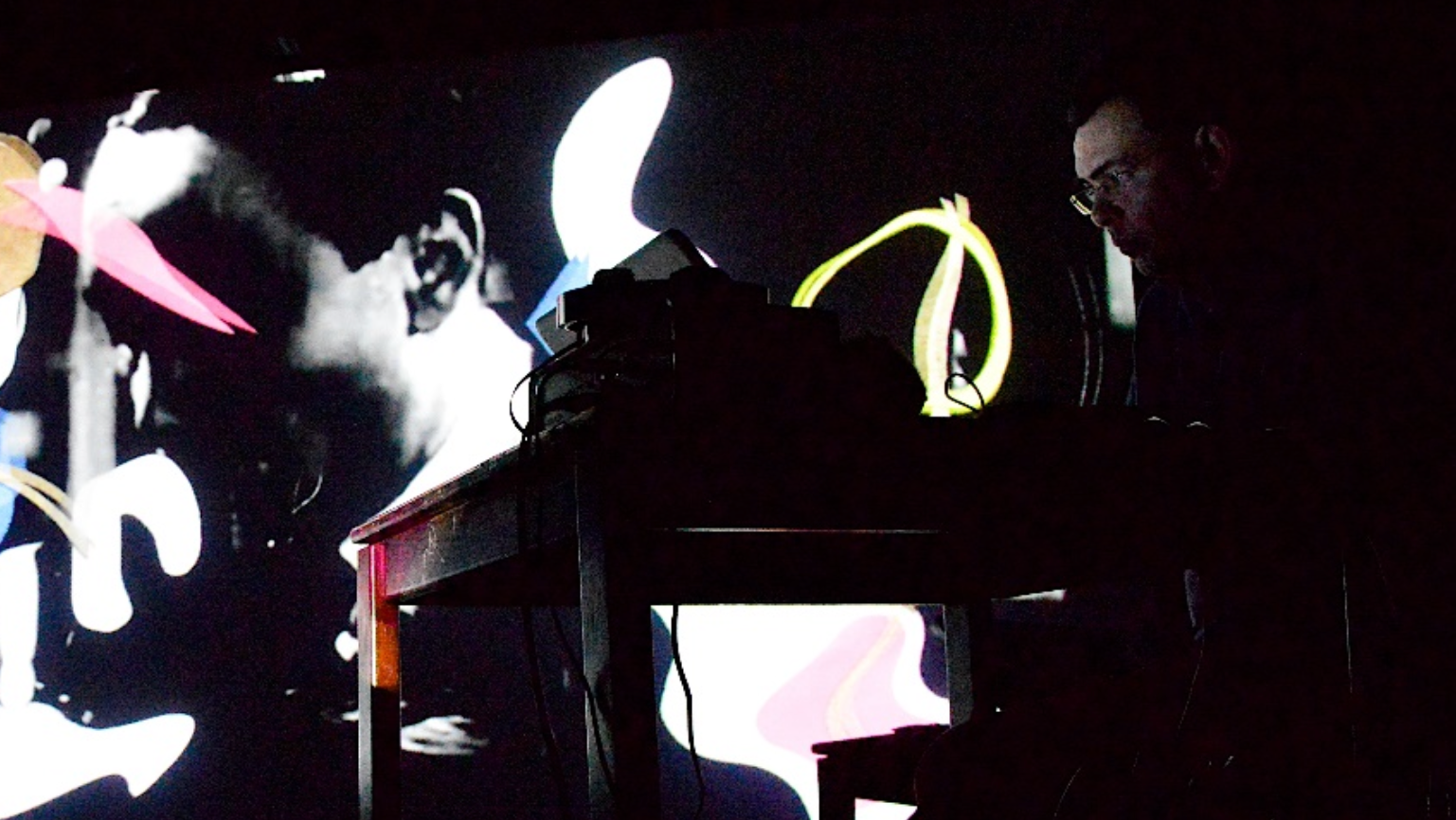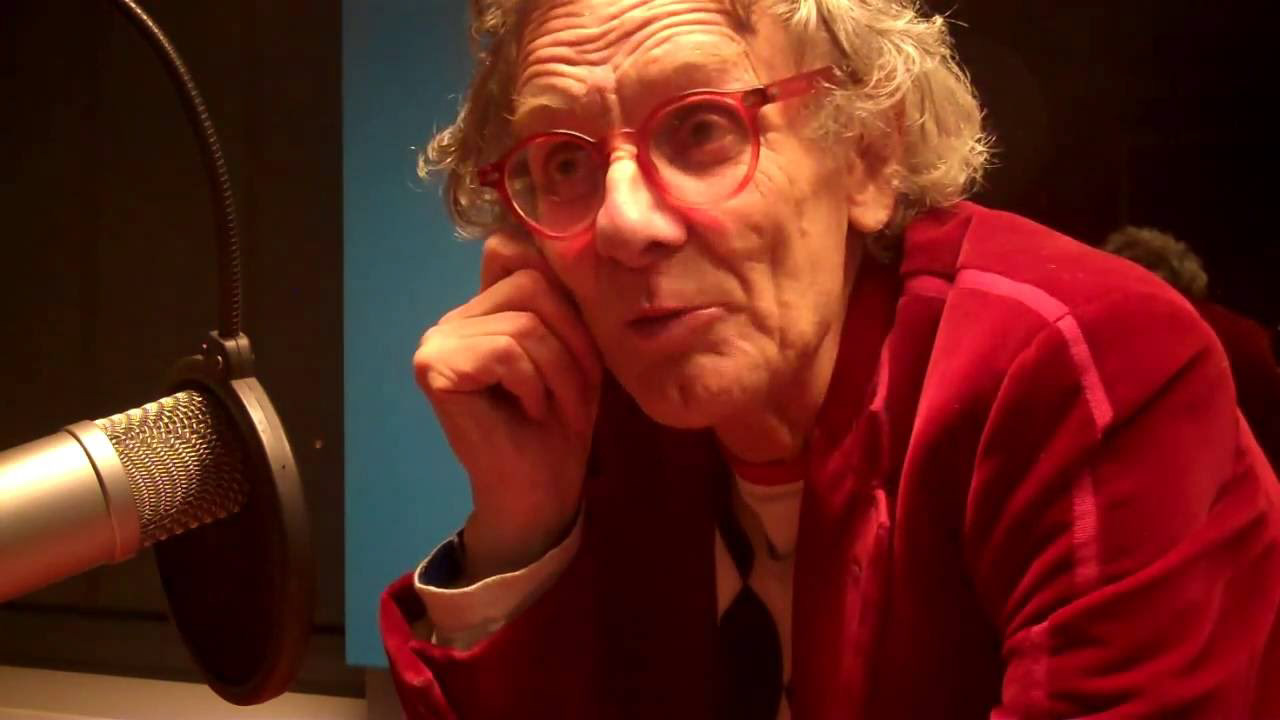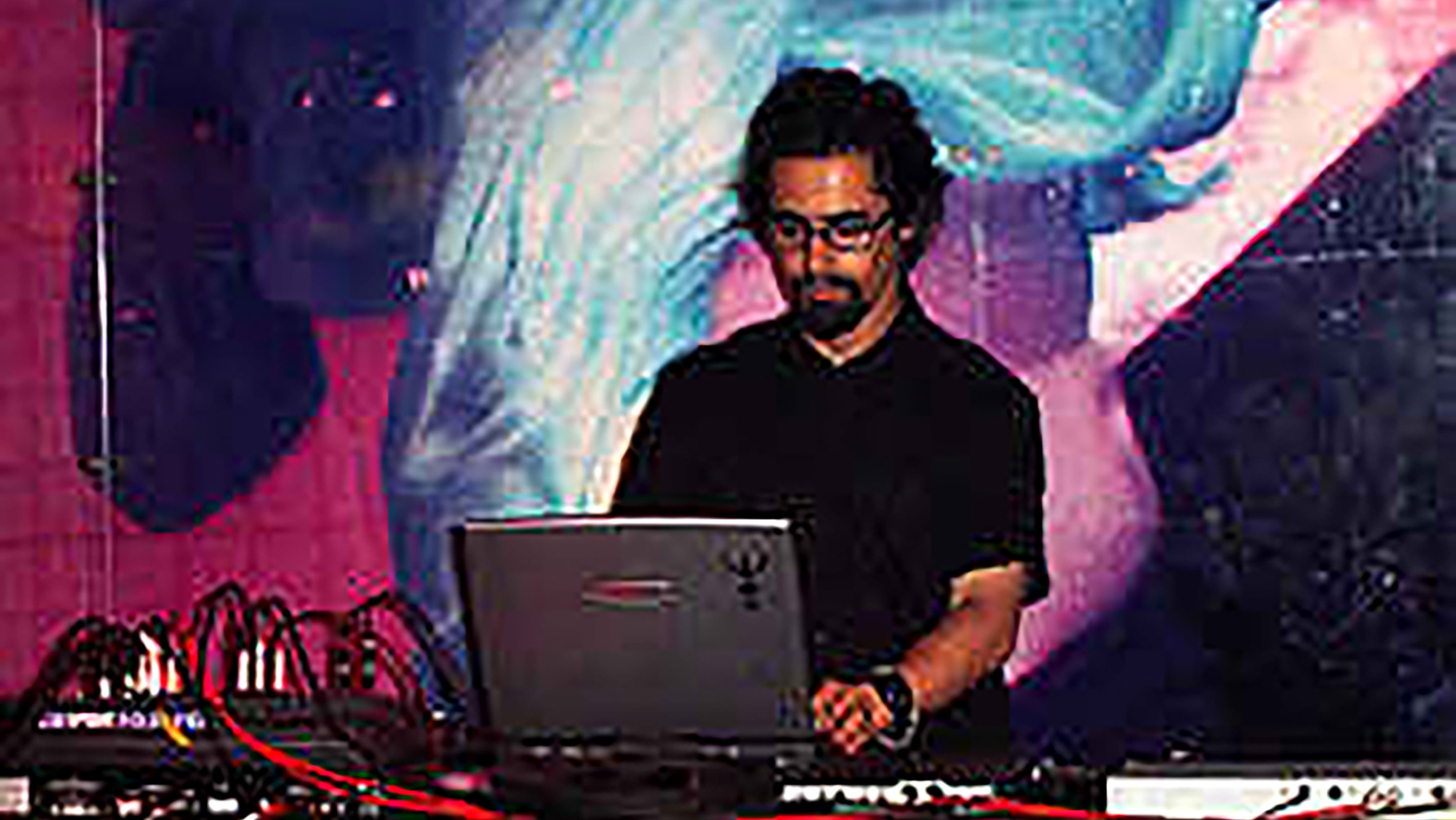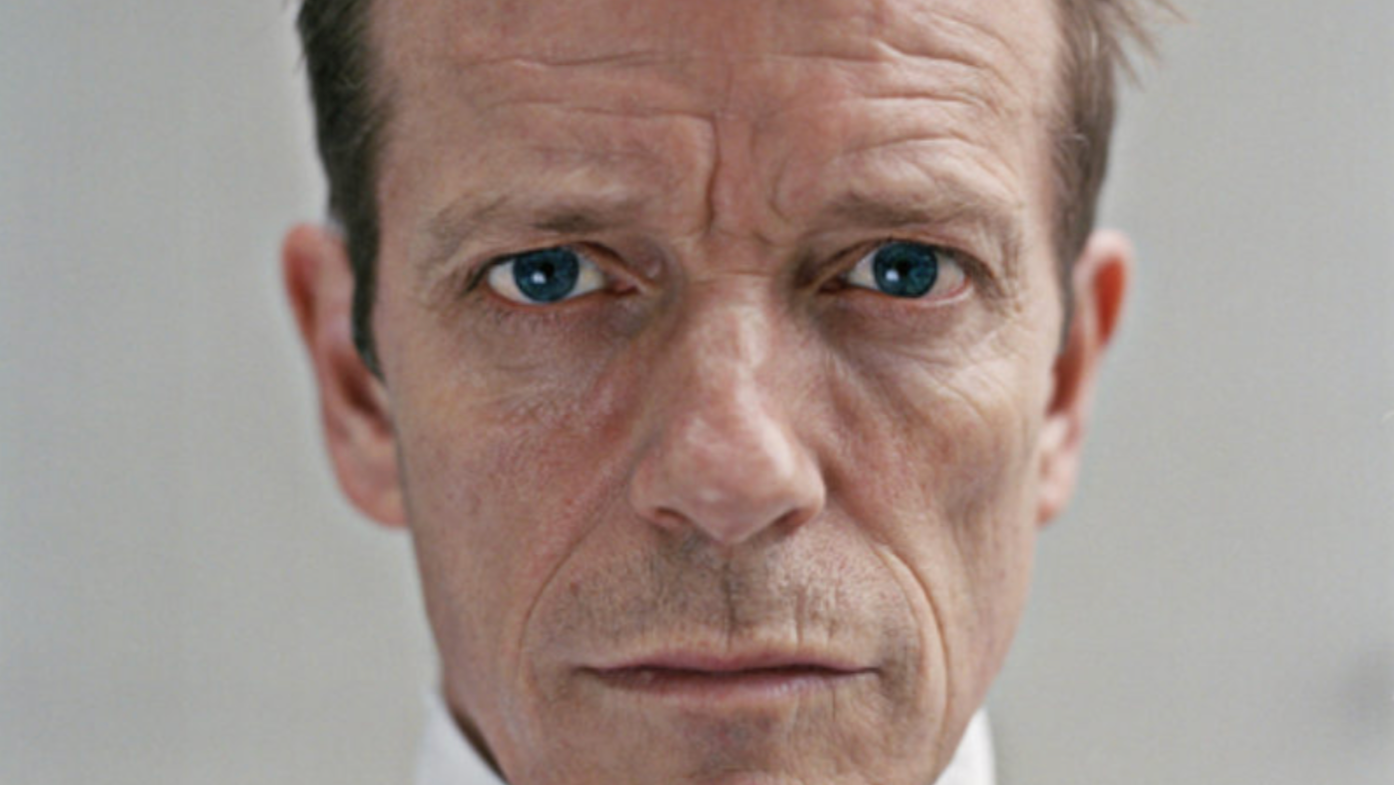Interview: CALAX-001 "ENEGY IS ETERNAL DELIGHT"
Siegmar Fricke
Siegmar Fricke (SF):
ハロー。
Hello.
Calax Records (CR):
ハロー。
Hello.
SF:
やぁ、やっと会えたね。信じられないよ。2万キロは離れてるよね。
Hi, it's incredible to see you. I think 20.000 kilometers away.
CR:
そうですね、こちらも会えてうれしいです。
Oh, Yes. Nice to see you.
SF:
こっちは午後で、とても晴れてるよ。 君たちの国は、今、深夜だよね。
You see, it's very sunny here because it is here this afternoon at the moment.
In your country, I think, it's now midnight.
CR:
はい。素晴らしいマスタリングとアートワーク、ありがとうございました。
Yes.
Thank you very much for the artworks and awesome masterings.
SF:
レコードの件、こちらの方こそありがとうと言わないと。
最初君たちから連絡を貰ったとき、とても驚いたよ。本当に素晴らしいことだ。
I have to thank you for your engagement in the record.
I was very surprised to receive your request for making the record. It's really great.
CR:
これがアルバムのカバーなんですが…
And here is the cover-layout for your album…
SF:
凄い!ポスターサイズだね!
Wow! It's incredible...real poster size!
CR:
ちょうどいま製造過程で、こっちがフロントカバーで、まだテストプリントなんですが、こちらがバックカバーです。
Currently, we're still in the production-process.
Here is the front cover. This is a test print. And it's going to be back cover...
SF:
素晴らしい!働き者だね!
いつも思うんだけど日本人は細部まで本当にこだわるよね。すごいことだよ。
だから、日本の印刷もすごく品質が良いんだろうね。
Wonderful! Lots of work!
I always think Japanese people pay a lot of attention to detail and it's great.
Therefore, especially Japanese pressings are very high quality.
CR:
このテストプレスは数日前に受け取ったばかりなのですが、少しすればこれが製品になります。
We got this test press of the record just a few days ago.
It's gonna be in production in a few days.
SF:
とても早いね!
今年は僕にとっても本当に信じられない年で、いくつか今年製造された最終版のレコードがあるのだけれど、見せてあげるよ。
これはスペインで作ったレコードなんだ。僕が“Siegmar Fricke”名義で活動をする前の1988年か89年に活動してた“Bestattungsinstitut”というインダストリアル音楽のプロジェクトなんだ。ディスコ調な“Siegmar Fricke”と並行してインダストリアル音楽も取り組んでたんだ。
So fast!
This year is really incredible for me because there are several final records that have been published this year and I can show you some.
This record is published in Spain.
It was a record of my former industrial project called “Bestattungsinstitut” in 1988 to 1989 before I started as Siegmar Fricke. I have always done this Industrial Music in parallel to the Siegmar Fricke disco tracks.
CR:
あなたのFacebookにもありましたよね。
It's the one we saw on your Facebook
SF:
そうだね。これがBESTATTUNGSINSTITUT ― Glandular Formationsのフロントカバーで、この写真は僕が1985年に作ったコラージュなんだ。僕はいつも音楽のメディカルな側面に取り組んでた。それは後でも説明できるね…。
Yes. The frontcover of BESTATTUNGSINSTITUT ‚Glandular Formations‘ involves a photo of a collage I made in 1985.
I was always working in the medical aspects of music.
But I can explain that later...
CR:
そうですね。では、最初の質問から始めてもいいですか?
Okay correct. Can we start from the beginning?
SF:
もちろん。
Yes
CR:
では、最初の質問です。あなたが現在住んでいる場所と、そこでどのように過ごしているか教えてください。
So, the first question is: Where is the place you live in now? And how do you spend time there?
SF:
いま、ドイツ北部の海沿いにあるWilhelmshaven(ヴィルヘルムスハーフェン)という場所に住んでる。たった10万人の市民がいる街で、いまはもっと少ないかな。多分8万人とか。とでも静かで、緑や公園も多い街だよ。ここにずっと住んでいて、自宅にスタジオもある。
いくつかキーボードもあって、古い機材が多くあるんだけど、ずっとこれらの機材は売ることもなかったから取ってあるんだ。
I have always been living there, in North Germany in Wilhelmshaven at the North sea.
It has always been a city of 100.000 habitants only, but now it's less even. I think 80.000.
And it's a quiet city with lots of green areas, park areas. I have always been living there and I have my home studio there.
I have here some keyboards and so many... There's also lots of old stuff that I have.
I still have some of the old equipment because I have not sold so much stuff.
CR:
古いものもあれば新しい機材もありそうですね。
これらの機材はすべて保管しているんですか?
Seems to include new ones and old ones… do you still keep all the equipment?
SF:
もちろん!だけど、いくつかの機材は交換したけどね。
90年代の機材もあるよ、 Solton Programmer 24 とか。
Yes, of course. But I have changed some of my equipment.
I still have some machines from the 90s like, for instance, a Programmer 24 from Solton.
CR:
続いての質問ですが、あなたが音楽を始めたキッカケを教えてください。
Second question is about the opportunity how you started making music…
SF:
すごく昔の話になるね…。
小さい頃から電子音楽に興味があったんだ。僕は1968年に生まれたんだけど、1981年にはレコーディングを始めてた。カセットレコーダーとトランジスターラジオを使って13歳の時に一番最初のレコーディングをはじめたんだ。
短波ラジオから流れてくるミュジーク・コンクレート(※1940年代後半の現代音楽のジャンルの1つ)や実験音楽の音をレコードしてたよ。ずっとノイズとか、変わってるサイエンティフィックな音に興味があったからね。そんな感じの音楽で活動を始めたんだ。ディスコっぽい音楽を始める前に。ディスコは1986年とか、もっと後になってからやり始めたんだよ。
最初の頃の方は、祖母が持ってたピアノの音も録音してたね。
It's really long ago...
I have been interested in that kind of electronic music since my childhood.
I was born in 1968 and I started with the first recordings already in 1981.
The oldest recordings were made at the age of 13, and I just used one cassette recorder
and one transistor-radio.
I recorded short wave sounds from the radio like concrete music or some experimental music because I was always interested in noises, strange scientific sounds. And I started with that kind of music before I was working on the disco songs.
The disco sounds came later around 1986.
In those early years I also recorded sounds from the piano because my grandmother possessed an old piano.
CR:
あなたの音楽に影響を与えたアーティストや友人、コミュニティはいますか?その人たちとの出会いを教えてもらえますか?80年・90年代の音楽シーンについて教えてください。
If you have some other artists or friends or community which influenced your music, could you tell us about the process of how you met them? We would like to know the scene of the 80s to the 90s. Has it changed your music?
SF:
答えるのがとても大変だね。
80年代は、レコード会社に連絡1つするのもとても難しかったんだ。RCAやCBSといった大きなレコード会社しかなかったから、自分の音楽をレコードに印刷する機会もなかったね。電子音楽に特化したインディペンデントなレーベルも多くなかった。
だから、実験音楽に取り組んでいるミュージシャンは、みんなカセットで音楽を始めてんだ。その時代に、今だとインダストリアルシーンですごく有名になった、非常に興味深い多くのミュージシャンとすでにコンタクトを取ってたよ。
本当に面白いミュージシャンがいたんだ。例えば、Conrad Schnitzler(1)だね。彼は2011年に亡くなってしまったけど。恐らく君たちも名前くらいは聞いたことあるんじゃないかな。彼はベルリン出身で’Kluster’(2)っていう実験音楽のプロジェクトの創設者なんだ。
Conrad Schnitzlerは、僕がコンタクトを取ったミュージシャンの中でも、最も重要な存在で、彼と会ったことが一番最初だった。当時、僕は18歳で、彼は既に50歳くらいだった。彼は60年代くらいから電子音楽に取り組んでいたからね。あと、Tangerine Dreamの最初のアルバムElectronic Meditation‘(3)にも参加してた。1987年にConrad Schnitzlerとのレコーディングセッションをはじめて、その時の音楽は後になってフランスでレコードとしてプレスされたんだ。
もう一人のミュージシャンはMaurizio Bianchi(4)だ。彼はミラノ出身で、イタリアの作曲家として非常に重要な人物だ。彼の音楽は、とても死を想起させる暗い性質の音楽で、非リズミカル、終末論的、流動的なんだ。現在でも彼はそんな音楽を続けているよ。
他にも面白いミュージシャンやグループはたくさんいるよ。
例えば、スペインのEsplendor Geométrico(5)とか。あとは、日本のMerzbow(6)とか。
あとは、ドイツのGiancarlo Toniutti(7)やKarlheinz Stockhausen(8)。Karlheinz Stockhausenは、50年代にアヴァンギャルド音楽を始めたミュージシャンの一人だ。
もちろん、8歳の時にはKraftwerkも聴いてたよ。1975年に彼らのアルバム’Autobahn’(9)を小さいときに初めて聞いたんだ。今思えばそれが最初のキッカケだったね。その時は、そんな音楽を聴いたことがなかったから、本当に惹きつけられたよ。
Yes, that's very complex to answer.
In the 80s, it was still rather difficult to contact record companies.
You didn't have any chance to publish your music on records because there were just the major labels, the big ones like RCA and CBS.
And there were not so many specialized independent labels at that time.
So all the musicians who were working in the experimental field started with publications of their music on cassette. And during that time, there were lots of contacts with very interesting musicians already, who are nowadays quite popular within the industrial scene.
There were several very interesting musicians, for instance Conrad Schnitzler(1) who died in 2011. Perhaps, you have heard about that name. He was from Berlin and he was the founder of the experimental project ’Kluster’(2).
Conrad Schnitzler was really the first important person in my contacts. I was 18 years old and he was already 50 years old at that time. He already started in the late 60s with electronics. He also took part in the first Tangerine Dream-record ’Electronic Meditation’(3). I recorded sessions with Conrad in 1987 which were later published on vinyl-records in France.
Another musician is Maurizio Bianchi(4) from Milano, a very important Italian decomposer.
He has continuously been working on non-rhythmic, apocalyptic, and fluid music of dark clinical nature.
And many other musicians and interesting groups. I always liked ’Esplendor Geométrico’(5) from Spain, for instance. And also from Japan, we have the electronic musician ’Merzbow’(6), you know.
And so many other projects like ’Giancarlo Toniutti’(7). ’Karlheinz Stockhausen’(8) from Germany. He was one of the first initiators of electronic avant-garde since the 50s.
Of course, I was listening to ’Kraftwerk’ when I was already eight years old. In 1975, when I was a child I listened for the first time to their piece ’Autobahn’(9). That was for me the real start. I was totally fascinated by those sounds that I have never heard before then.
CR:
小さいときから既に洗練されていたんですね。
Already sophisticated since your childhood.
SF:
そうだね。
Yes.
CR:
日本人でお気に入りのミュージシャンはいますか?
Do you have any favorite Japanese music ?
SF:
もちろん!Yellow Magic Orchestraは全て作品がお気に入りだね。
あと、僕にとって重要な人物がいて。Tetsu Inoue(9)というアーティストだ。彼の音楽はとっても実験的なアンビエントで、かつ、瞑想的で、とても素晴らしいんだ。
彼は日本人のミュージシャンの中でも魅力的なアーティストの一人なんだけど、数年前に音楽シーンから消えてしまったんだ。彼の所在に関して、何の情報もないんだ。誰も彼がどこにいるかわからない。最後の消息は2008年か2009年だったかな。ウェブ上にも情報はないし、調べてみたら何かあるのかもしれないけど。
Of course. Yellow Magic Orchestra’s all the releases.
And one musician, a very important project for me. His name is ’Tetsu Inoue’(9) and his music is very ambient experimental, very meditative, and deep fantastic.
He is one of the most fascinating Japanese musicians who disappeared from the scene many years ago. No information regarding his whereabouts. Nobody knows where he is, because the last life sign was in 2008 or 2009. No information on the web. Perhaps you can find out something.
CR:
今、日本語のWikipediaで彼に関することを調べているのですが、記事によると彼は今アメリカに住んでいるようです。それ以上の詳細な情報はないのですが、恐らくニューヨークかどこかにいるんでしょうか。
We are now searching for him and found his wikipedia in Japanese. It says he's living in the United States right now. But we don't see about details but he might be in New York or somewhere…
SF:
彼はニューヨークのアーティストとも多くコラボレーションしていたし、ドイツのAtom™’(10)とか。彼もまた多作なミュージシャンだね。
当時、日本には興味深いカセットレーベルがたくさんあって、いくつかの実験音楽も日本で発表されてた。特に、MerzbowのMasami Akitaの周辺とか。
彼の音楽を調べてみてよ、すごくうるさいけど笑
He collaborated with several artists in New York also with a musician ’Atom™’(10) from Germany, also a very prolific musician.
There were lots of interesting Japanese cassette labels at that time. Some very experimental music was published in Japan. Especially around Masami Akita of Mertzbow.
You can have a look at his music. It's only very loud.
CR:
次の質問はSPHレーベルに関してです。Fernandoのレーベルから、A Thunder Orchestraと共同でリリースした背景を教えてください。
Next question is about SPH. Could you tell me the process of co-releasing with A Thunder Orchestra at Fernando's label?
SF:
SPHはポルトガルのレーベルだったよね。 当時のテープシーンの中で、多くのレーベルからオファーの連絡があったけど、SPHはその内の1つのレーベルだったね。
その前から、彼らとは既に面白い音楽を出してたんだ。
話を戻すと、A Thunder Orchestraとはそれまで連絡をとったことはなくて、だから僕とA Thunder Orchestraの作品をそれぞれテープとして出したのはSPHが決めたんだ。
だから、それぞれ音楽をテープで組み合わせたのは偶然であって、音楽のスタイルもそれぞれ異なっていると思う。A Thunder Orchestraの音楽は少しメランコリックな印象がある一方で、僕の方は素材としてはストレートなディスコハウスな音だからね。
SPH was a label from Portugal, I think.
It was one of many labels that I was in contact with during the tape scene at that time.
I received lots of requests from many labels, and SPH was one of those labels.
They already published some very interesting music before.
But I was never personally in touch with A Thunder Orchestra because that was a decision by SPH to make a split tape of both projects.
So, it was just by chance to combine those projects on tape and I think our styles are a bit different. A Thunder Orchestra sounds a bit more melancholic. In other hands, my music was more straight disco house material.
CR:
あなたのことを調べているときに、当時のあなたの音楽を作るアプローチに関する記事を見つけたのですが、それによるとあなたは当時、ラジオからの音をサンプリングする形で音楽を作っていたとありました。
When we researched you, we found an article which was about the approach of your music creation by cutting up sounds from radio.
SF:
そうだね、当時はヘッドフォンでラジオをたくさん聴いてたんだ。サンプリング用のキーボードを直接ラジオに繋いでね。
テクノミュージックが始まったばかりだったこともあって、ラジオからテクノがたくさん流れてたんだ。それは僕にとってまったく新しい音楽で、そんなダイナミックな音楽の形にとても惹かれていた。
だから、直接キーボードをつないでラジオから興味深い音が流れてきたら、サンプラーのボタンを押して、マルチトラックカセットレコーダーに録音してた。90年代のレコーダーもあるよ。オリジナルは1987年に壊れたから、買いなおしたものだけど。
新しいのはYAMAHA製のモノで、これは現在とっても高価な値段でやり取りされてて、見つけるのも大変なんだ。90年代後半にはみんなデジタル音楽に興味があったんだけど、今はみんな再びアナログに戻りつつあるよね。
アナログはいま多くの人にとって、手に触れることができるからか、より魅力的な存在になっているんじゃないかな。対して、デジタル音楽だとダウンロードするみたいに、抽象的なプロセスだし。
だから、主にはサンプリング用のキーボードとプログラマーで作ったシーケンスで音楽を作ってたんだ。これは、僕が1992年に使っていたシーケンサーだよ。
Soltonのプログラマーを、CrumarやKORG DW600といった他のシンセサイザにmidiで接続したりしてね。
Yes. At that time, I was listening a lot to the radio with headphones.
I directly connected my sampling keyboard to the radio.
There were lots of interesting broadcasts about Techno music because Techno just started in those days. It was totally new for me and always fascinating to listen to this new form of very dynamic music.
So, I directly connected my sampling keyboard. When there were interesting sounds on the radio, I pressed the record button on my sampler and recorded the material on a 4-track-cassette recorder.
I can show you my current four track recorder from the 90’s. I bought it afterwards, because my original one from 1987 was broken.
My new one is YAMAHA, and it is very difficult to find and quite expensive now... In the late 90’s, people were more interested in digital music but now they come back to analog.
Analog is more attractive for many people because you have something in your hands.
On the other hand, with digital sounds such as downloading it is an abstract process…
So I mainly worked with the sampling keyboard and the sequences I made with my programmer.
Here you can see my sequencer I used in 1992. The Solton programmer was connected by midi with other synthesizers like the Crumar synthesizer or KORG DW 6000.
CR:
では、本アルバムにある “This is John”もラジオからのサンプリングされた音が含まれているんでしょうか?
So, “This is John” also involves sampled sounds from the radio?
SF:
そうだね、だけどカッティングや変調、一部、反復やスピードを上げたりといった加工を多く加えてね。そういったエフェクトをたくさん使って、それらを組み合わせるやり方をしていた。
Yes, but with lots of cutting and modulation and partly reversed or speeded up. And I've usually put lots of effects and combined them.
CR:
製作にはコンピュータも使用していたんでしょうか?
Did you use a computer at that time for making music?
SF:
いや、当時はコンピュータを持ってなかったね。
90年代はみんなAtariかCommodoreのコンピュータを使っていたと記憶してるけど、僕は1981年から1996年までの間、もっぱらアナログで取り組んでたんだ。1997年にハードディスクへのレコーディングをはじめて、ラップトップを使うようになったのはもっと後だね。
No, I did not possess any computer at that time.
I remember in the 90’s many people were working with Atari or Commodore computers but I was exclusively working in the analog field from 1981 to 1996. In 1997 I started with hard disk-recording and later with the laptop.
CR:
ミキシングやマスタリングをあなた自身で行うことによって、あなたの音楽のコンセプトを際立たせているのでしょうか?もし可能なら、そういった機材を紹介してもらえますか?
Doing the mixing and mastering by yourself, does it make the concept of your music stronger? And, if possible, can you introduce what kind of equipment you use?
SF:
当時、マスタリングは僕にとってあまり重要な要素ではなかったね。カセットのレコーディングに取り組んでいたこともあったし、マスタリングもそこまでオプションも多くはなかったしね。
曲をレーベルに送ると彼らの方がマスタリングしてくれてたから、レーベルがCDやカセットのリリースをするときには、マスタリングに僕自身が関わることはなかった。
マスタリングはもっと後になってから行うようになって、僕が2006年にコンピュータで音楽を作るようになってからかな。今、僕はMacbookを使っていて、マスタリングはCubaseやIzotopeといった他のプログラムでやってるから、当時と現在では大きく変わったね。
マスタリングには細心の注意を払う方にしているし、また、コンピュータを使うようになってから僕の音楽のスタイルも変化した。最適な音の大きさとクリアなサウンドで録音するようにしているんだ。
At that time mastering was less important for me because I was mainly recording on cassettes and there were not so many options to make a proper mastering.
When I sent the music to the cassette labels, they did the mastering. If they wanted to publish it on cassette or on the CD I was not involved in mastering.
Mastering came later when I started to work with a computer in 2006. Now I work with a Macbook and do all the mastering in Cubase and several other programs like Izotope... It's totally different now.
I pay lots of attention to mastering. And my musical style changed when I started to work with a computer. I tried to record the sounds in optimal loudness and clear sound.
CR:
1991年に本作品”Energy is Eternal Delight”をリリースしてから30年もの月日が経ちましたが、あなたの音楽のテイストも変化したように思えます。何か変化する特別なキッカケはあったのでしょうか?また、90年から現在まで、どのような形であなたの音楽を発展させていったのでしょうか?
After releasing “Energy is Eternal Delight” in 1991, 30 years have passed. We can see the different taste in your music. Is there any particular opportunity for changing? And how did you develop your music from the 90's up to the present?
SF:
そうだね。
僕の音楽やその他の芸術の進展には、根本的な変化があったと思うよ。
だけど、僕自身の中には常に実験的な側面があったんだ。
当時、リズミカルなディスコミュージックと実験音楽を並行して取り組んでいたんだけど、僕は常に非メロディックな音楽や、不協和音を帯びた実験音楽、あるいはアバンギャルドな音楽、コンクリートなどに興味があったんだ。だから、コンピュータでの音楽制作を2006年に始めた時に、Pharmakustik(12) (13)というより実験的なプロジェクトにフォーカスするようになった。
なので、Pharmakustikが今、取り組んでいるメインのプロジェクトなんだ。
そのプロジェクトでは、音楽のメディカルな側面にフォーカルするようにしていて、Pharmakustikで音楽を作るとき、医学用の顕微鏡写真のようなメディカルなイメージに関連する、SFチックな音楽のように聞こえるんだ。また、Pharmakustikでの音楽の作り方も外科手術のプロセスのようなものを想起させる、と言えるかもしれない。音をカットしたり、埋め込んだり。また、コンピュータで音を変調や反復させることも、医学的なアプローチとも関連しているよね。
加えて、僕はディスコサウンドに取り組む以前の1984年から、既に視覚的なコラージュ作品にも取り組んでいたんだ。一番最初のコラージュは新聞の切り抜きを含むものだった。それが、僕の音楽にも相互作用をもたらしていたのかもしれない。
音楽に取り組むとき、常に多くのアイデアがあったんだけど、それと同時に、音楽をコラージュとして視覚的な表現に落とし込むこともできた。逆もまた然りで。また、音楽と連動して、ビデオ作品も同時に作っていたんだ。いくつかビデオを作ったんだけど、そこにも以前から作ってきたコラージュが入っているし。そのビデオも、有機的かつ音響的な音楽と組み合わせながら、映像自体は映画のカットアップやコラージュからできてるんだ。
Yes, I think there is a fundamental change in my musical and artistic development.
However there was always the experimental side inside myself.
At that time, I was working on rhythmic disco music aon experimental structures in parallel.
I was always interested in non-melodic, dissonant experimental music, avant-garde music, concrete and so on. When I started to work with the computer in 2006. I've mainly focused on my project Pharmakustik(12) (13).
Pharmakustik’ is the main project I'm working on now.
Pharmakustik focusses on the exploration of medical aspects in music. When I compose works for Pharmakustik, it sounds like science fiction music with relation to medical aspects such as microscopic pictures. And also the way the music is produced in Pharmakustik has a lot to do with surgical procedures, you can say. It's a creative process of cutting sounds and implantation of sounds. And on the computer you can reverse or modulate and so on. It all has to do with the medical approach.
Besides, I started to work on my first visual collages already 1984 even before the disco sounds. The first collage involved newspaper cut-ups.
Also like your business, the kind of you can say it's a kind of interaction.
When I work on music, I usually have lots of ideas and I could visualize this music in visual collages and vice versa. In combination with the music, I'm always working on videos as well. There are several videos I made, which also involve collages I developed before. And these are cut ups from films and collages combined with organic sounds and acoustic sounds.
CR:
とても面白いですね。
最近の展示についても教えてください。
This is really interesting.
Could you tell us more about your recent exhibition?
SF:
そうだね、昨年、幸運にもドイツ北部にあるギャラリーがソロでの展示をオファーしてくれて、6週間もの期間、僕の41個の作品が展示されたんだ。いくつかの作品は1984年から2019年の期間に作られたものだ。
Yes…last year, I was lucky that a gallery in North Germany offered me the opportunity to have a solo exhibition. 41 works were presented in my exhibition for a period of six weeks, involving some of my collages from 1984 till 2019.
CR:
あなたは音楽からコラージュといった視覚的な芸術まで、幅広く活動をされていますが、そういった活動を継続的にさせる特別なエネルギーはあるのでしょうか?
You continue to carry out a wide variety of creative activities from music to visual arts. What is the driving force behind these activities?
SF:
人生から受けるすべての印象が僕自身の中にあるフィルタを通して、作品として出てくるんだ。だから、そういった何かを生み出そうとするエネルギーは常にあるよ。TVの前で受身になって過ごす代わりにね。僕は今も継続して精力的だし、コラージュや音楽にはずっと取り組んでいたいんだ。外にいるときは写真も撮ったりするよ。
アートワークも、他のミュージシャンともコラボしたりすることもあって、徐々に発展しているんだ。例えば、僕の友人であるイタリアのMaurizio Bianchi(14)ともたくさんコラボしているよ。彼がベースの素材となる音楽を送ってくれて、僕がその音を電子的に調整し、それをまた素材として彼に送るんだ。
All impressions from life are filtered inside myself and then come out as artworks.
So there's always a driving force to do something instead of being passive in front of the TV.I am continuously active and prefer to work on collages and music all the time. Even taking photos when I'm outside.
Artworks slowly develop, partly in combination with other musicians. For instance, I'm collaborating a lot with my friend ’Maurizio Bianchi’(14) from Italy.
He often sends me basic sounds and I'm tweaking his sounds electronically and send the material back to him for publication.
CR:
とても面白いですね。
新型コロナウイルスによって全世界中が大きな変容を求められていますが、そういった環境の変化があなたの音楽や考え方に影響を与えることはあったでしょうか?
Very interesting.
With coronavirus, all the world is forced to change dramatically right now. Did that change influence your music or any thoughts?
SF:
僕のアーティストとしての環境には、変化があったとは言えないね。
いま外の環境もあって、ずっとスタジオに閉じこもることが多いし。だから、今までよりも自分の仕事に取り組める環境だね。
特に今年は、このような状況もあって政治的に動機付けられたコラージュもたくさん作ったし。だから、僕のクリエイティビティにとっては、非常にポジティブな影響を与えてくれた環境だと思う。
I would not say that my artistic situation has changed.
Because now, of course, you are staying mainly in your studio due to the situation outside. And you can keep your work even more intense than before.
Especially this year, I made lots of politically motivated collages due to this situation.
So, the situation even has a positive effect on creativity.
CR:
素晴らしい!
最後に、リリースに際して、この作品がオーディエンスに届くことに対して何か思うことがあれば教えてください。あるいは、このLPを手に取ってくれる人に。また、私たちとあなたとの関係のように新たな繋がりが増えるかしれないことにも、何か想いはありますか?
Fantastic!
Finally could you give us a message if you have anything you like to convey to your audience of this work is releasing? Any messages for people who buy this LP.
How do you feel about this new connection between you and us?
SF:
既に言った通り、本当に素晴らしいことだよ。
特に、君たちのような90年代に生まれた世代が、僕が90年代にカセットでリリースした作品に惹かれていることがね。
2016年と2018年に、ベルリンでライブを演奏したんだけど、それもとってもエキサイティングだった。僕がライブで演奏を終えた後、その後のDJが僕の90年代に作った音楽をプレイしてくれたんだ。ダンスしているオーディエンスも25歳か30歳くらいの人が多くて。
僕が作った音楽は、どうやらその世代の人たちに確かな影響があるみたいだね。
だから、君たちの世代が僕の音楽を再発見してくれたのは、本当に有難いことだ。
It's really great as I already mentioned.
Especially the people of your generation born in the 90’s are fascinated by my music that I released on cassettes during the 90’s.
It was really exciting when I was playing live in Berlin in 2016 and 2018. After my live gig the DJ also played some of my music from the 90’s. There were many people at the age between 25 and 30 who were dancing all night to this music.
The sounds I created must have a certain effect on that generation, I think.
So I really appreciate that people of your generation have re-discovered my music.
I'm really grateful for that.
CR:
私たちも、あなたと一緒に取り組めて感謝の気持ちでいっぱいです。改めて、ありがとうございます。
We also appreciate working with you… thank you so much.
SF:
インタビューに関してもどうもありがとう。 話せてよかったよ。話すことはたくさんあるんだけど、今、君たちの方は何時くらいかな?
I have to thank you so much for the interview. It's really great to talk to you. There's so much to talk about. What time do you have now?
CR:
00:30ですね。
It's 00:30.
SF:
どうやって、SPHや“Energy is Eternal Delight”を見つけたのかな?
And where did you discover SPH and ’Energy is Eternal Delight’?
CR:
オーストラリアの”Strange Holiday”というラジオ番組があって、もう放送は終了してしまったのですが。その番組を好んでよく聴いてた中で、あなたの曲を知りました。
We found your music in Australian radio named “Strange Holiday” and I love to listen to this program but it's now over. One day, I listened to the mix from this program and I found your music.
SF:
なるほど。
Yes.
CR:
“This is John”がキッカケの曲でした。そしてインターネット上で調べはじめ、Youtubeで音源を見つけ、その後、Discogsであなたの情報を見つけた後にFacebookであなたにコンタクトを取った、という運びです。まさに、インターネット!ですね。
That song was “This is John”. And I researched on the Internet and I found the full music on Youtube. Then, we contacted you on facebook after reading the information at Discogs. So…internet!
SF:
なるほど。Discogsは本当に素晴らしい。僕のリリースした作品情報も、過去のものから現在のモノまで全て網羅して一覧化されているし、とてつもないネットワークを形成しているよね。
というのも80年代には、そういった古い音源を見つけるのも困難だったんだ。インターネットも存在しないし。みんな、カタログや雑誌に自分の音楽を発表していたんだ。
Yes, I think Discogs is great. It's a great network because it shows all my releases of the past until today.
Because in the 80’s, it was difficult to find old material and there was no internet.People were just offering their music in catalogues and magazines.
CR:
そういえば先程、”Energy is Eternal Delight”のリリースに当たって、SPHからオファーを貰ったと仰っていましたが、Fernandoはどうやってあなたの連絡先を見つけ、どのようにしてオファーしたのでしょうか?
You said you got requests from Fernando, SPH to release “The Energy is Eternal Delight”. How did Fernando find your contact and send an offer?
SF:
すべての情報がテープシーンに繋がっていたんだ。それは、1つのネットワークだった。
タイプライターを持っていた人がテープマガジンを作って、すべてのテキストを紙に打ち込み、コピーを刷り、そしてディストリビューションまでしていた。その雑誌には、レーベルの連絡先も記載されていた。だから、すべて手作りでできていて、当時の人と人の繋がりでディストリビューションもされていたんだよ。
今だと、そのすべてはインターネットに置き換わって、数秒あれば情報を手に入れることも容易だけど、でも当時は、人に情報を伝えるにも数週間は掛かった。
だから、テープシーンはとても整理されていて、素晴らしいネットワークだった。毎週、世界中から、時には日本から、アメリカから、そしてヨーロッパからたくさんのカセットを受け取っていたよ。
It was all connected to the tape scene. It was a network.
There were also tape magazines made by the people who had a typewriter. And they were writing all the text on paper and they made photocopies of it and distributed those magazines. In the magazines, there were the addresses of labels. So it was all handmade and distributed through the people at that time.
Now it's all done by the internet. You now are able to get information within seconds.
But at that time, it took weeks until the people were informed.
So the tape scene was very organized and it was a fantastic network and every week I received lots of cassettes from all over the world, sometimes from Japan, also from America, and from Europe.
CR:
そこで、Merzbowなども見つけたんですね。
So, you found Merzbow within that network.
SF:
そうだね。80年代前半の当時、彼らはあまり有名でなかったからカセットを作っていたんだ。
Yes, at that time, he was still making cassettes because he was not so popular in the early 80’s.
CR:
そのテープシーンのネットワークは誰が始めたんでしょうか?
Who started organizing this network do you know?
SF:
それは、世界のある1つの地点から始まった、というものではなくて、世界中のあらゆる国で同時多発的に始まったんだ。最も初期のカセットは80年代前半に作られたと思うんだけど、1981年から緩やかな盛り上がりがあり、シーンとしてのピークは1985年〜1986年だったかな。
ピークの後、1993年くらいにテープシーンは消失したね。当時、みんなCDにより興味が移っていてからね。僕もその同時期にCDへ移行したから、テープシーンの消失は僕の音楽活動におけるカセットというフォーマットで取り組むことの消失でもあった。1993年か1994年には、CDに曲を書き込むことができたんだ。
だけど、今や、デジタルが飽きられつつあって、みんなカセットで音楽を表現することに再び関心を示し始めているね。多分みんなこう考えてるんじゃないかな、「カセットで音楽を発表するなんていい時代だったなぁ、だから、僕らもカセットで再び始めてみよう」って。
It came not only from one point in the world but together started in every country at the same time so earliest cassettes were published in the early 80’s i think from 1981 it slowly started it climaxed in 1985 ~ 1986.
There was a climax for the cassettes and then it disappeared in 1993 because at that time the people were more interested in CDs. That was also the cut for me because, at that time, I started with CDs. It was possible to burn your own music on CDs around 1993/94.
However now the people are interested again in publishing music on cassette because digital downloads have become less exciting. Now the people think: ’Oh it was a nice period to publish music on cassettes so we can restart with the cassette-format.’
CR:
私も同じような経験がありました。僕らはカセットやヴァイナルに自然と親しんでいた世代ではないのですが、友だちとmp3を集めていることがあんまり面白くなくなってしまったんです。
The same experience I had recently so actually I'm not familiar with vinyl or cassette naturally. I shared and collected mp3 with my friend but I think now it is not like just digital is not interesting.
SF:
まさしくだね。
MP3は色々なものを損なわれた、質の良くないフォーマットだから。そのかわり、ヴァイナルなら全ての周波数があるしね。
That is true.
MP3 is a very reduced format of less good quality. Instead, on vinyl you have the whole spectrum of frequencies.
CR:
なので、私たちもダウンロードコードなどは今回のリリースにはつけないようにしています。それがコンセプトにあるので。
So that is why for releasing we don't put download codes for our releases. that's our concept.
SF:
いいね!
いいね!
信じられないくらい遠く離れた距離だけど、君たちとリアルタイムに話せてとてもよかったよ。多分、2万キロくらいかな。
Nice!
Really great to talk to you in real time despite the incredible distance. Yes, might be a distance of 20.000 kilometers.
CR:
恐らく。
コロナウイルスが落ち着いたら、是非、リアルでもお会いできればと思っています。
いつかドイツに旅行して、再びお会いできるといいなと。
Maybe.
We hope we can physically meet some day after corona.
We would like to travel to Germany, so I hope we can see each other again.
SF:
もちろん。とにかく、Skypeでも連絡が取れるから定期的に話そう。素晴らしいよ。
Of course, anyway we are in touch by skype so we can regularly make conversations on skype… that’s really great.
CR:
ありがとうございます。
Thank you very much.
SF:
是非、引き続き連絡を取り合おう!
では、おやすみ、良い週末を。
Keep in touch yes!
Have a good night and a nice weekend.
CR:
ありがとう。
Thank you.
SF:
バイバイ。
Bye bye.
CR:
バイバイ、ではまた。
Bye bye, see you
_________
2020. Oct.
by Yoshiaki Miura and Yusei Yamamoto
from Calax Records in Tokyo, Japan
